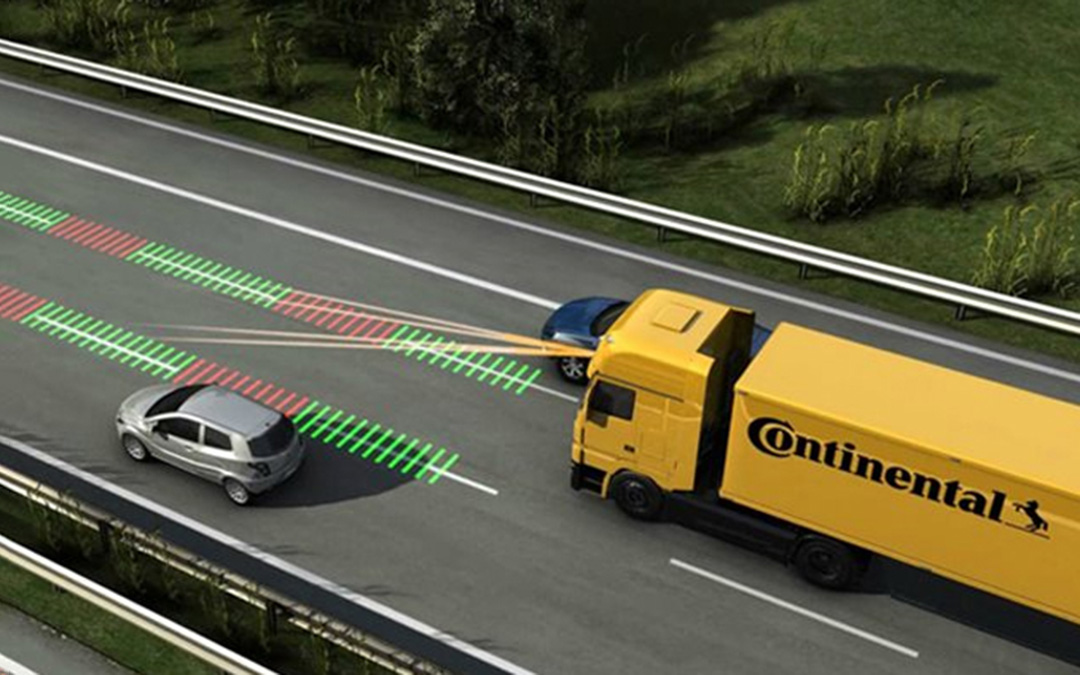The EU’s General Safety Regulation (GSR), which has been passed in 2019, aims to drastically reduce the number of accident victims by means of state-of-the-art safety technologies. This ranges from alcohol immobilizers and intelligent speed assistants to tire pressure monitoring systems, lane change assistants and numerous other intelligent driver assistance systems. For example, the turn-off assistant has been made mandatory for all heavy vehicles, since 2022 for new vehicle types and from 2024 for all new registrations.
At Continental, we have been working on advanced driver assistance systems (ADAS) for commercial vehicles that increase safety on the roads for a while now. Our radar sensors and camera systems offer a wide range of functions, from emergency braking and right-turn assistants to intelligent high-beam assistants. Our goal: to develop reliable safety technologies that go beyond the requirements of general safety regulations.
Sensors and cameras provide driver assistance functions
For example, our sensors and cameras enable driver assistance functions such as lane departure warning, emergency brake assist and intelligent cruise control. Our SRR520 short-range radar easily mounts behind the bumpers and monitors the areas in front and behind the vehicle. The ARS410 and ARS430 long-range radar sensors provide a wide field of view, detect stationary obstacles, and employ high-value features such as Adaptive Cruise Control, Forward Collision Warning, and Emergency Brake Assist.

Blind spot detection of a bike next to the truck. Photo: Continental.
Everything in sight
We developed our Surround View system to give drivers new and previously impossible perspectives around the vehicle. It allows them to check the blind spot when changing lanes on the highway or to drive into a parallel parking space without endangering the rims. Meanwhile, the surround view segment includes numerous display-only systems and intelligent products, compact rearview systems, mirror replacement systems, and the next generation of 3D surround view systems. Scalable surround-view solutions are ensured by four fisheye cameras with a horizontal field of view of over 180 degrees. This allows drivers to see everything around their vehicle.
Danger averted
Rear-end collisions on highways are among the most feared dangers, especially when heavy trucks are involved. Our third-generation radar sensor embodies the long-needed protection. It can trigger a predictive emergency braking system, which brakes automatically as soon as the driver’s own vehicle comes dangerously close to a vehicle in front and the driver fails to react appropriately.
Our blind spot detection system uses radar sensors mounted on the side of the driver’s cab to scan the vehicle’s surroundings for objects when maneuvering and warn the driver if necessary.
Lane keeping
Lane Departure Warning (LDW) uses a camera to detect the lane up to 40 meters away. It warns the driver if the vehicle is about to leave the lane unintentionally. In conjunction with electric intervention in the steering, LDW becomes an active Lane Keeping Assistant (LKS). A gentle steering recommendation is another warning to the driver, and the driver’s decision always takes precedence.

Continental’s support to keep the line through innovative technologies. Photo: Continental.
A cost-effective addition to Lane Keeping Assist is Intelligent Headlamp Control. It ensures better visibility in the dark. The system detects oncoming vehicles and those ahead and adjusts the headlights to ensure the best lighting in every situation and that other road users are not dazzled by the high beam.
Traffic sign recognition ensures that speed limits and other traffic signs are continuously displayed to the driver. Automatic recognition is achieved by linking camera images with speed limit information stored in the navigation system.
What experiences have you already had with driver assistance systems – and which would you like to see in the future? Don’t hesitate to leave a comment and tell us all about it!


0 Comments